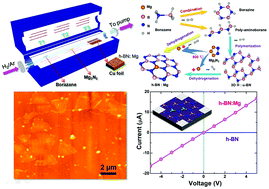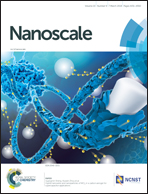p-Type conductivity of hexagonal boron nitride as a dielectrically tunable monolayer: modulation doping with magnesium†
Abstract
Hexagonal boron nitride (h-BN) is the widest band gap 2D material (>6 eV), which has attracted extensive attention. For exploring potential applications in optoelectronic devices, electrical conductivity modulation (n or p type) is of extreme importance. Here, we report the achievement of a large-scale and high quality h-BN monolayer with p-type conductivity by modulation doping of Mg using a low pressure chemical vapor deposition method. A large-scale monolayer h-BN (>10 inches) was grown by using a wound Cu foil roll on a multi-prong quartz fork. Magnesium nitride is used as a dopant precursor in a separate line due to its appropriate melting point and decomposition temperature. Density functional theory calculations revealed that the acceptor level introduced by Mg is almost pinned into the valence band and the activated holes are highly delocalized into the surrounding h-BN lattices. The h-BN:Mg monolayer showed a p-type conductivity with a considerable surface current of over 12 μA and a hole density of 1.7 × 1014 cm−2. The dielectrically tunable h-BN monolayer makes the fabrication of advanced 2D optoelectronic devices in short wavelength possible.



 Please wait while we load your content...
Please wait while we load your content...